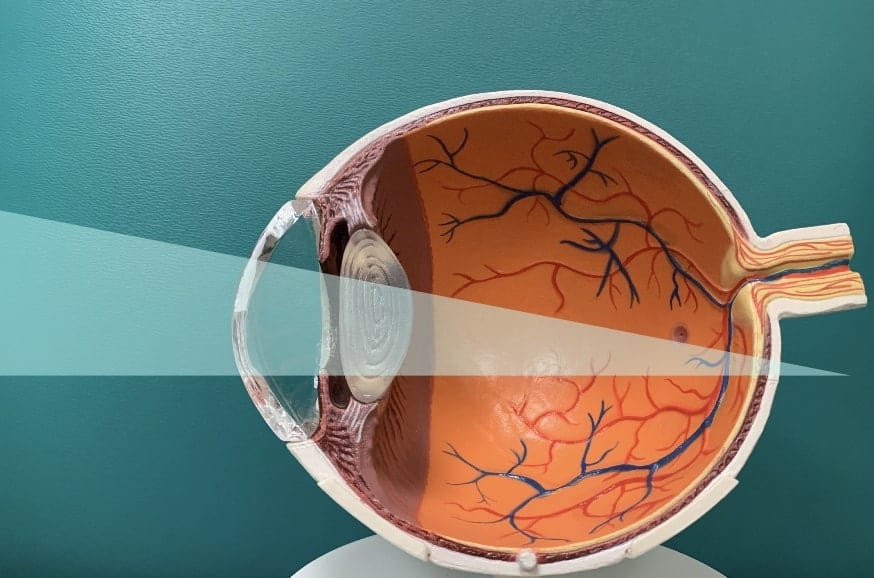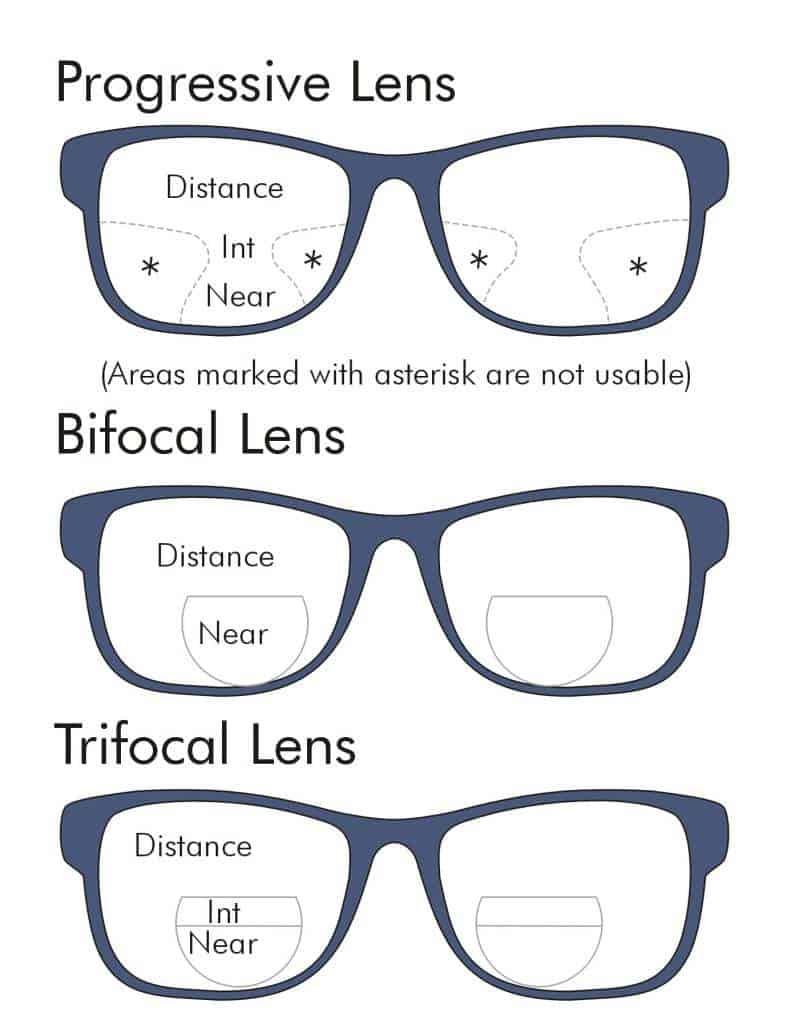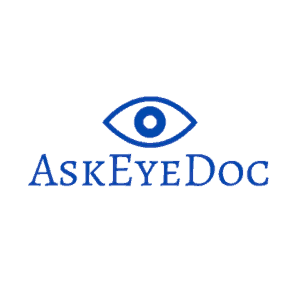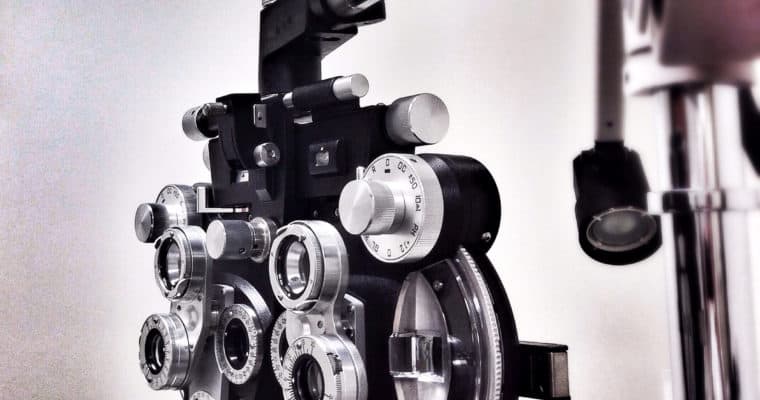Written by: Dr. Stephanie Mulick, O.D.
A refractive error is a term used to describe the way light is bent when it comes into your eye. Refraction means the bending of a wave, in the case of the eye we are referring to bending light waves. An Optometrist will perform a Refraction (the dreaded “Which is clearer 1 or two?” test) to determine the power of the lens required to get our patients clear vision. The lens power is measured in quarter step Diopters.
Myopia (Near-sighted)
A near-sighted eye is a longer eye, which means that when the light from a distant object comes into the eye, instead of focusing directing onto the retina it focuses in front of the retina (as illustrated in the photo below), causing a blurry image. When looking at a near object the light moves closer to the retina, making near objects clearer for a near-sighted eye.
A myope or near-sighted eye is able to see near objects, but distant objects are blurry.

Glasses for a myopic eye would have a minus powered lens, for example, -2.00 Diopters. The lens to correct myopia is concave meaning it is thicker on the edges and thinner in the middle. This type of lens creates minification, meaning that things may appear smaller especially the eyes of the person wearing the glasses. The longer a patients eye is the more myopic they are and the higher (or thicker) the lens power will be to improve their vision.
Hyperopia (Far-sighted)
Hyperopia or far-sighted means that the individual has a shorter eye and light focuses behind the retina. This makes it more difficult to focus on near objects. Even-though a far-sighted eye sees better at a distance than up close, they still find improvement in distant vision with glasses and the near vision can be much improved with glasses. It is not uncommon for a hyperopic (far-sighted) patient to complain of eye strain or headaches after prolonged near work (ie: computer, phone, or reading).

Glasses for a Hyperopic eye would have a plus powered lens, for example, +2.00 Diopters. The lens to correct hyperopia is convex, meaning it is thicker in the center and thinner on the edges. This type of lens creates magnification, meaning things may appear larger, even your eyes will look larger when you are wearing this type of lens. The shorter a patient’s eye is the more hyperopic they are and the higher the lens power (or thicker the center of the lens) will be to improve their vision.
Presbyopia
Presbyopia means loss of focus or accommodation. The lens in our eye adjusts our focal point by accomodating or changing shape to move the light onto the retina when we look up close. As we advance in age the lens becomes thicker and more difficult to accommodate the light. This causes us to lose the ability to focus on near objects. Now, a near-sighted eye will see up close better without glasses, but for everyone else, the need for reading glasses will become a progressive need.
One of my patients explained presbyopia as “after 40 vision”. I thought that was a cute way of saying it, but he is true. Presbyopia does usually start in our 40’s and progresses until about age 60.
Presbyopia causes us to need reading glasses, that is unless you are near-sighted and just remove your glasses to see up close. But for someone who is perfectly corrected to see clearly at a distance, when they become presbyopic the need for reading glasses will progressively increase with time until about age 60 at which point it doesn’t tend to get worse.
After the age of 60, it is more common to start seeing the development of cataracts that can affect the vision causing glare and halos at night and the need for more light especially when reading. Cataract development will progress until eventually cataract surgery is needed (review my post on cataracts for more information).
Glasses for Presbyopia would have an ADD power which is an additional reading power that is added to the power of lens needed to see at distance.
Lenses to correct Presbyopia
There are a few options when it comes to correcting your vision with glasses if you have presbyopia.
Bifocals:
Most people are familiar with the term bifocals which means two focal points, the top section of the lens is set for distance and the bottom section is set for reading up close. Bifocals have a line delineating the top section for distance and the bottom section for reading.
Benjamin Franklin was credited for the invention of bifocals between 1760 and 1770; however, some think that they were used even 50 years prior. Benjamin Franklin called these glasses “double specs.” It wasn’t until John Isaac Hawkins invented trifocals (lenses with three focal points) in 1824 that he coined the terms bifocals and trifocals.
Trifocals:
A trifocal is a lens with 3 focal points. A trifocal lens will have two lines: the top of the lens is set for distance, the middle area is set for intermediate (about arm’s length) and the bottom is set for reading up close.
Progressive Lenses:
According to Hall of Fame Honors in the Vision Monday article, Irving Ripps, founder of Younger Optics, created his version of a progressive lens in which he called “invisible bifocal” or seamless lens in 1955. However, Progressive type lenses date back as far as 1907.
Progressive lenses gradually change focal points from the top of the lens for distance and the bottom of the lens for reading. This gradual change in focal points gives the wearer the ability to see at multiple distances depending on where they are looking through the lens. The center of a progressive lens will allow someone to see arm’s length, which is good for viewing the dashboard of the car or even a computer screen.
A progressive lens does not have any lines like a bifocal or trifocal. Irving Ripps’ “invisible bifocal” was said to make the wearer look younger; hence his company name: Younger Optics.
Progressive lenses have revolutionized glasses, going from “geek to chic.” Nowadays, glasses are a fashionable part of someone’s wardrobe.
Progressive lenses have come a long way since 1955. They are now produced digitally using computerized technology. Some large retail companies still use older or generic progressive technologies to save costs for themselves and the consumer. These cost-saving progressive options can work for some patients but have a higher rate of non-adaptation, meaning that the patient is unable to adapt to wearing progressive lenses. This leads to people wearing bifocals, trifocals, or separate pairs of glasses (distance, computer, and reading).
If you have tried progressive lenses from a large retail store and have been unable to adapt to them, you may still be a candidate for progressive lenses using a higher quality lens. Most private Optometry/Optical shops will carry the highest quality progressive lenses. Keep in mind that the higher quality lenses do come with a higher price tag (you get what you pay for, as they say).

Correcting Presbyopia with Contact Lenses:
Presbyopia can be corrected with Contact lenses; however, comes with some visual compromise.
Contact lens options for presbyopia correction:
- Distance vision correction in contact lenses will still require reading glasses.
- Monovision: Dominant eye for distance viewing and Non-Dominant eye for Near
- Multifocal Contact lenses: A contact lens that is corrected for both distance and near
Contact Lens Options for Patients over 40 (Presbyopia)
| Type of contact lens | Dominant Eye | Non-Dominant Eye | Advantage | Disadvantage |
| Distance only | Contact Lens for Best Distance Vision | Contact Lens for Best Distance Vision | Great distance vision | Reading glasses are needed |
| Monovision | Contact Lens for Best Distance Vision | Contact Lens for Best Near Vision | Usually do not need glasses. | Decreased depth perception |
| Multifocal | Contact lens for both distance and reading | Contact lens for both distance and reading | Better depth perception than monovision | complaints of glare and halos have been noted |
Astigmatism
The term astigmatism means that there is an irregularity to the shape of the eye causing light to bend in many directions. The irregularity of the eye can be caused by corneal astigmatism or lenticular astigmatism or a little of both.
Corneal Astigmatism means that the cornea or front of the eye is not perfectly spherical (round). Lenticular astigmatism means that the lens inside of the eye is irregular. Both types of astigmatism cause vision distortion and blur.

Without getting deep into optics, a non-astigmatism prescription for glasses is called spherical and would look something like this: -2.00DS (Diopters sphere) or -2.00sph (sphere). Glasses that correct astigmatism would have a number called the cylinder and axis and look something like this: -2.00 -1.25 x 180. The middle number is the cylinder and the third or last number is the axis, this is the part of your prescription that corrects your astigmatism.
Treatment for Refractive Errors (Myopia, Hyperopia, Presbyopia and Astigmatism)
- Glasses can correct refractive errors to aid in visual acuity
- Contact lenses are an option for all types of Refractive Errors
- Refractive surgery can be done for all types of refractive errors (here is the link for my post on refractive surgery options).
Conclusion:
A myope or near-sighted eye is able to see near objects, but distant objects are blurry.
Hyperopia or far-sighted means that the individual has a shorter eye and light focuses behind the retina. makes it more difficult to focus on near objects.
Presbyopia or “over 40 vision” means loss of focus or accommodation.
The term astigmatism means that there is an irregularity to the shape of the eye causing light to bend in many directions.
In the ever-changing fast-paced society that we live in, it is important to have clear vision. For those of us who are dependent upon glasses and contact lenses, it is important to know our options.
I am so grateful for glasses and contact lenses. I started wearing glasses at age 5 and probably needed them before that. Without my glasses and contact lenses, I am only able to see 1 foot in front of my face.
Glasses and contact lenses have come a long way and are continuing to improve. There are many options available when it comes to improving your sight and with new technologies, the options keep getting better.


